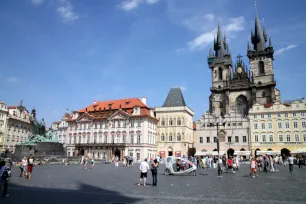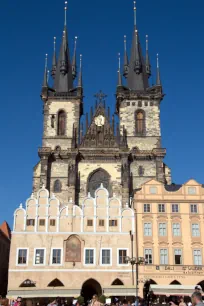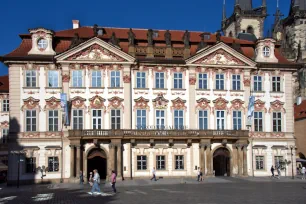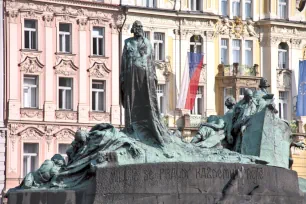The Old Town Square and the surrounding quarter form the heart of the city of Prague. The lively square is lined with magnificent buildings in different architectural styles, from Gothic to Baroque.

In the fourteenth century, the city built around the Prague Castle expanded to the right bank. The history of the square goes back even further: as early as in 1091 a market existed at the site of the Old Town Square.
The square and surrounding streets are pedestrian zones, and during summer tourists relax and have a beer here at one of the many outdoor cafés while being surrounded by many remarkable medieval buildings. The whole square is bordered by colorful houses, palaces and churches. Some of the most prominent buildings around the square are the Old Town Hall (famous for its astronomical clock), the Týn Church, the Kinský Palace and the St. Nicholas Church.



Old Town Hall
The most famous building on the Old Town Square is the fourteenth-century Old Town Hall. Its Gothic tower, built in 1364, is one of the most recognizable buildings in Prague.
The tower is famous for its magnificent astronomical clock, built in 1410. It is the oldest such clock in Europe. Throngs of tourists gather in front of the clock every hour to witness the procession of miniature figures.
St. Nicholas Church
To the north, the square is bordered by the eighteenth-century St. Nicholas Church. It is one of the most beautiful of all Baroque churches in Prague, and its interior is especially impressive.
Among the other buildings on this side of the square stands a profusely decorated building in Jugendstil style. It was erected at the end of the nineteenth century for an insurance company, but was later used as a government building.
Týn Church
The Týn Church is probably the most recognizable church in Prague thanks to its many spires. Construction of the Gothic church started in the fourteenth century, but the spires were only finished in 1511. In front of the church is the historic Týn School, an arcaded Gothic building that gives access to the church.
Nearby is another interesting Gothic building: the House at the Stone Bell. The building had a Baroque facade, but it was removed in 1980 to give the building back its original fourteenth-century appearance. Note the beautiful Gothic windows.
Kinský Palace


To the left of the House at the Stone Clock is the Goltz-Kinský Palace, a beautiful building with a delicate Rococo facade. Originally built by the Goltz family, the building was later purchased by Kinský, a diplomat of the emperor. In February 1948 Klement Gottwald, the communist leader, held a speech from the balcony of this palace which would eventually lead to the proclamation of a communist state.
South Side of the Square
The south side of the square is composed of a series of beautiful buildings with colorful Renaissance and Baroque facades. Some of the most notable buildings include the Štorch House, a Renaissance building with a painting of St. Wenceslas and ‘At the Stone Table’, a nice example of Baroque architecture.
Other buildings bear names such as ‘At the Golden Unicorn’, ‘At the Stone Ram’, ‘At the Red Fox’ and ‘At the Blue Star’. The names of the buildings were often derived from signs or plaques. The house ‘At the Stone Ram’ for instance is named after a stone relief on the facade that depicts a young virgin with a ram. These names had a practical purpose: in the past houses were not numbered, so they were identified by their name.
Jan Hus Monument

In the north-east corner of the square is the large Jan Hus Monument. It was erected in 1915 to mark the 500th anniversary of the reformer’s death at the stake. Jan Hus, born in 1369, was besides a reformer also a fervent Czech nationalist. In 1415, he was declared a heretic at the council of Constance.
The monument depicts the persecution of the Czech nationalists and their reemergence two hundred years later, with the imposing figure of Jan Hus at the center.

Marian Column
Just south of the Jan Hus Monument stands the Marian Column. This 16-meter-tall column was originally built in 1850 to celebrate the victory of the Bohemians at the Battle of Prague during the Thirty Years’ War. It showed a pedestal with allegorical figures and a statue of the Virgin Mary at the top of the column. In 1918, when the Habsburg Empire was on its last legs, Czechoslovak Nationalists demolished the monument, which was seen as a symbol of oppression. The surviving remains of the monument are displayed in the Lapidarium.
In the 1990s, after the dissolution of Czechoslovakia, proposals were made to reconstruct the column as a sign of reconciliation. It would take until 2020 before the city council approved the reconstruction. That same year, the column was rebuilt on the Old Town Square, albeit without the allegorical statues of archangels fighting evil that used to adorn the pedestal. However, it is possible that they will be added later.
- Next: Old Town Hall
- More Sights & Attractions in Prague

